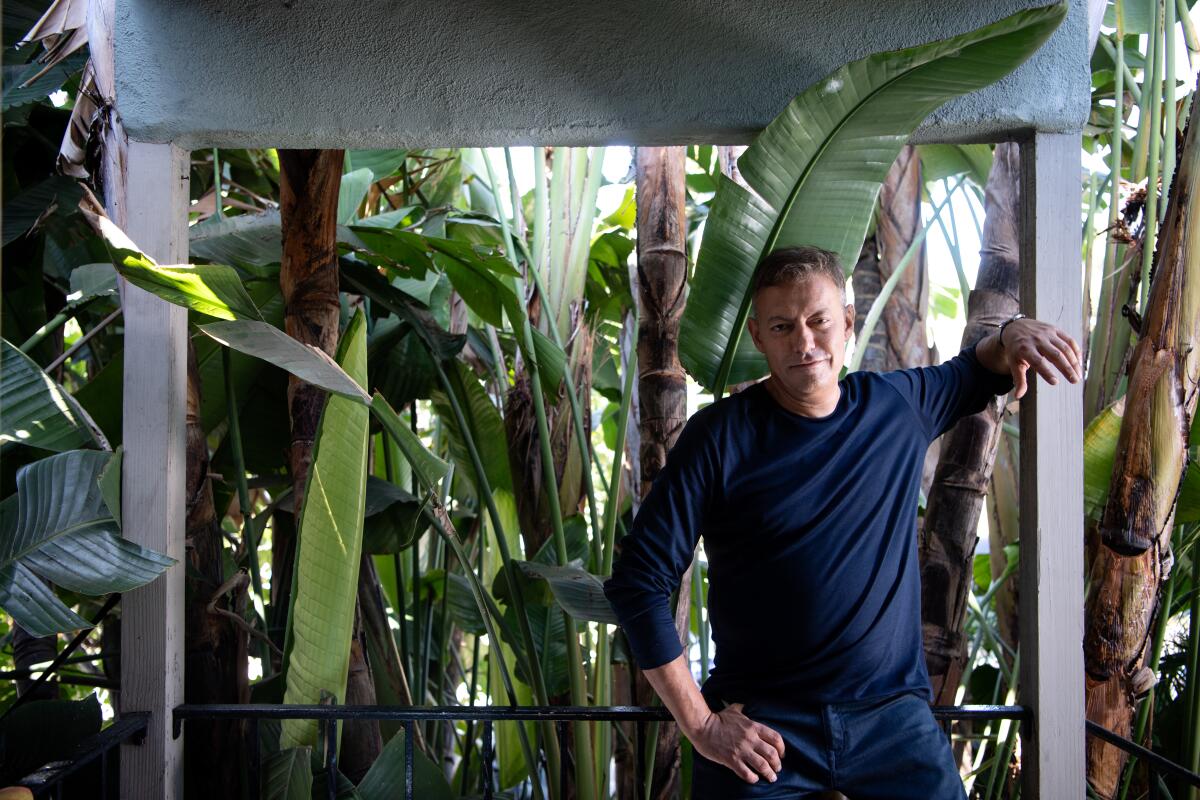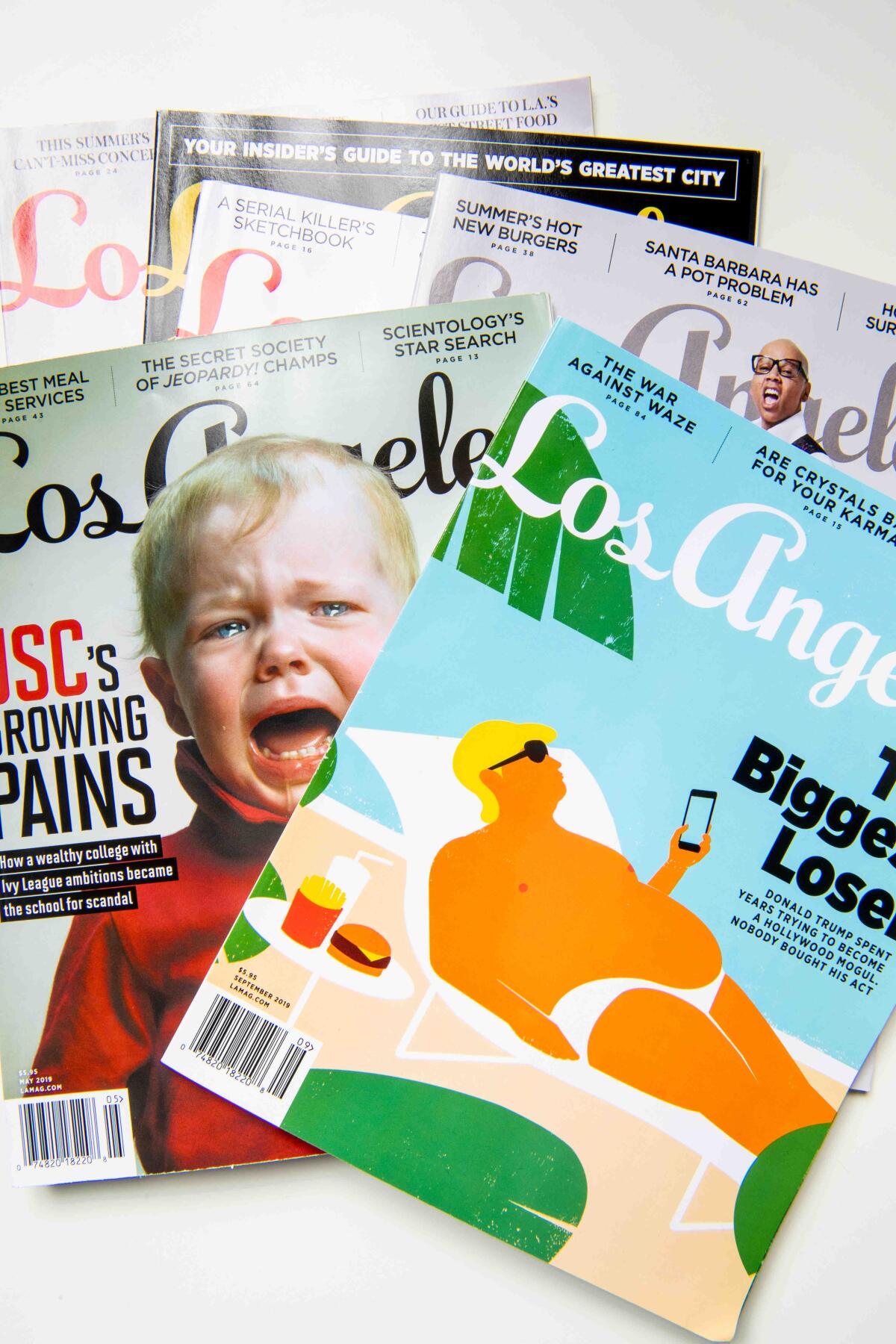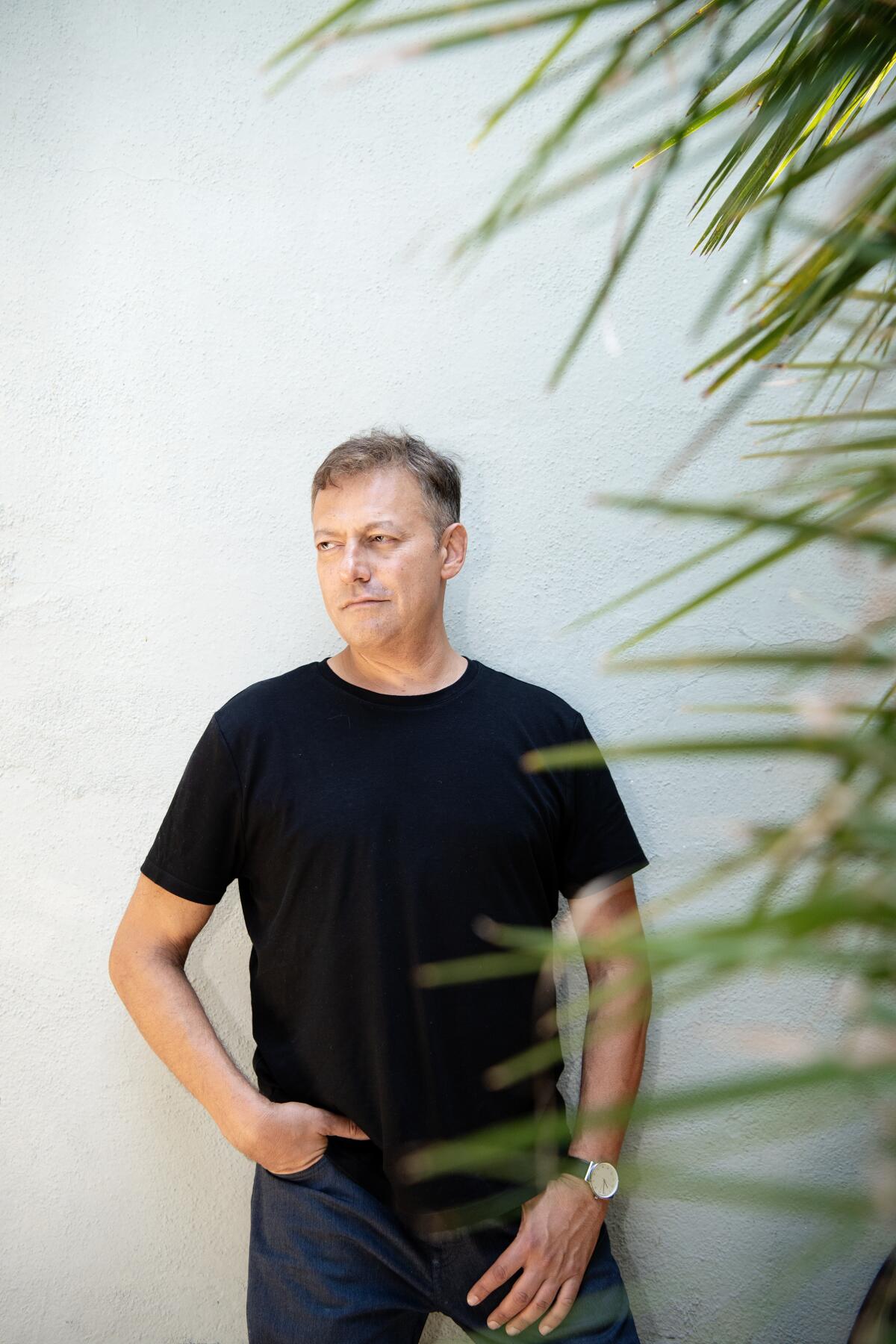He may hate the word ‘buzz,’ but Los Angeles magazine editor Maer Roshan is creating it

- Share via
An early summer lunch with Maer Roshan, the recently appointed and ninth editor in chief of Los Angeles magazine, began routinely enough. What could be more normal than a couple of Angelenos sitting down to compare notes on the previous night’s earthquake? “I was having dinner with a friend at the Century City mall,” Roshan said in his gritty, Marlboro Light-cured voice. “Suddenly the lights began swinging and it’s like, ‘Well, it’s happening again.’ But no one screamed or anything.” He almost sounded disappointed.
A waiter appeared at our table in a dark corner of Eve, the bistro in the recently restored Beaux Arts-style Mayfair Hotel in downtown L.A., to announce that the chef had prepared a special tasting menu for us. If print journalism is dying, helming a city magazine apparently still has its perks — tuna tartar tacos and oxtail sopes, to be specific, and that was only the first course.
“I have something for you,” Roshan said, extracting the cover page for the August issue of Los Angeles from his leather office bag. In keeping with the magazine’s long tradition of “Best of” coverage, it was a “Best of L.A.” issue — but instead of an obvious image of a billboard or a marquee, the cover featured a whimsical cartoon by the husband-and-wife team of artists known as DabsMyla, inspired by one of its murals downtown. It reflects Roshan’s resolve “to keep what Los Angeles was — where to go, what to eat — but also to be more topical and newsy and have energy and a voice.”
“I hate the word buzz,” he elaborated, “but the magazine needed buzz.” In addition to tips on the best workout under 30 minutes and the best nontoxic nail salon, the August issue contained a scrappy piece on Los Angeles County Sheriff Alex Villanueva. July’s cover story, a Q&A with actress Louise Linton, the deeply controversial wife of Treasury Secretary Steven Mnuchin, was so buzzy it earned Roshan a few minutes on CNN. September features a lacerating account of Donald Trump’s clumsy efforts to become a Hollywood macher. (The cover line: “The Biggest Loser.”)
It was not hard to generate heat, Roshan said, covering the new cultural capital of the country: “It’s undeniable that over the last decade, L.A., fashion-wise, politically for sure, the arts community — all this stuff that was East Coast-centric has gravitated west.”

Roshan himself gravitated west in stages. In 1979, when he was 12, his family fled revolution-torn Iran, resettling on Long Island. After graduating from New York University and launching a gay weekly, QW, he readily earned a reputation as an “editorial boy wonder” (per the New York Observer), serving as deputy editor of New York magazine; editorial director of Talk, the short-lived glossy created by Tina Brown; and founding editor of Radar, a dishy magazine and website that tracked the zeitgeist of the aughts with stories on Damien Hirst and “toxic bachelors.” Somewhere along the way, Roshan, like Brown, became a story himself, his comings and goings clocked in gossip columns such as Page Six.
In 2008 — after a rocky publishing history and a succession of volatile owners including Jeffrey Epstein — Radar folded. Roshan, who said at lunch that he had recently fielded “a million calls” from reporters regarding his ties to Epstein, believes that early reports of the financier’s sexual proclivities prompted Epstein’s co-investor, Mort Zuckerman, to pull his support from Radar in 2005. He started to describe a visit to Epstein’s “dark and surreal” townhouse on the Upper East Side. But Spencer, the Mayfair’s catering manager, had arrived to take us on a less spooky tour.
We rode an elevator to the second floor to view the hotel’s art gallery, curated by the graffiti artist RISK, and to the third floor to see the ballroom, a soaring space with exposed bricks and beams. Waiting for the down elevator, we watched another car disgorge a guy in a mouth mask and gangsta wear and two women sporting thigh-length platinum wigs, schoolgirl kilts and platform boots. “Anime Expo,” Spencer explained. “They’re back from the convention center.”
“Fringe youth culture!” Roshan exclaimed. “My thing!”
He wasn’t kidding. Ten minutes and a short Uber ride later, we were standing outside the glass-and-steel Los Angeles Convention Center Annex surrounded by hundreds of pointy-eared Pikachu, top-hatted steampunks and pink-haired princesses. (Novelist Bret Easton Ellis, a friend of Roshan’s since the 1990s, said such subcultural detours were classic Roshan: “A few years back we were going out to dinner, but Maer wanted to meet at the Scientology center beforehand, take a little tour and have Scientology people attach E-meters to us.”)
“Oh, look at this guy! Hey, can I take your picture?” Roshan, hobbled by a bad back, made his way over to a gold-armored warrior, who struck a not very fierce pose. He returned and lit a Marlboro Light. “I should call our fashion editor and have her come down and shoot next week’s style page.”

An uncostumed man with a pair of headphones wrapped around his neck overheard Roshan and struck up a conversation. He was a video artist, recording sound for a film on anime. “Maybe we can use some of that for our website,” Roshan said, fishing a business card from his bag. When the video artist went off to capture more sound, Roshan got out his phone and texted someone. “Oh, yeah,” he said under his breath. “We’re already doing an anime story.”
No matter. Another half-hour at Anime Expo would inspire potential pieces on couples who meet at conventions, Compton Pride (an event held the same weekend) and the backlash against influencers (don’t ask, something to do with Hello Kitty).
A storied past, an uncertain future
Los Angeles is the oldest independently published city magazine in the country. It was founded by a UCLA undergraduate and an ad executive in 1961, and soon boasted local contributors like Ray Bradbury and Joseph Wambaugh. The publication pioneered the use of celebrity covers as well as that city-magazine staple, the service issue (“Top Doctors,” “52 Great Weekends”). After ABC bought it in 1977, issues swelled to the size of phone books.
While other local titles came and went — remember Buzz? New West? — Los Angeles prevailed. In 2000 the Walt Disney Co. (which had acquired ABC) sold the magazine to Emmis Communications for a whopping $30 million. But like most print publications, it has struggled for ad revenue in recent years. In 2017 Emmis unloaded the title along with three other magazines for $6.5 million. The buyer, Detroit-based Hour Media Group, promptly laid off more than a half-dozen staffers, including the magazine’s then-editor, Mary Melton. In terms of its heft, Los Angeles today more closely resembles an alumni quarterly than a phone book.

The first thing you notice about the magazine’s headquarters, in a sleek skyscraper designed by William L. Pereira & Associates and located across Wilshire Boulevard from LACMA, is how quiet they are. A honeycomb of empty cubicles stretches across the 10th floor. Roshan’s full-time editorial staff has been whittled to eight people.
He holds two staff meetings a week, one for the magazine and one for the website, lamag.com. At a recent website meeting, the conference room looked pretty full, but interns and freelancers made up much of the head count. Roshan solicited story ideas from everyone in the room, responding to unpaid summer interns and seasoned journos like “the Maerettes” (style writers Merle Ginsberg and Susan Campos) with equal fervor.
Among the pitches:
—How Uber drivers get “deactivated.”
—The new, improved protective netting at Dodger Stadium. (Roshan suggested a “history of head hits” at the ballpark.)
—Robot employees in L.A. restaurants and bars.
—The cancellation of a Pete Buttigieg fundraiser at Ryan Murphy’s house.
The last idea was Roshan’s. “The magazine shied away from political content before,” he said back in his office, a large corner suite with presumably inspiring views of LACMA and, behind scaffolding, the new Academy Museum of Motion Pictures. “They shied away from industry content too, I guess because they thought Hollywood was covered by other people. But we should be covering institutions and people that matter in this city.” Of course the institutions and people that matter in a place as sprawling and balkanized as Los Angeles depend on whom you ask — or, more to the point, where you ask — but Roshan insisted that stories like the one on Sheriff Villanueva “have a payoff that people will be interested in whether they’re living on the Westside or the Eastside.”

As a monthly, Los Angeles depends on its website for the currency Roshan covets. He has doubled the daily content of the site, expanding its pool of contributors and ramping up video coverage to “drive the conversation,” whether it be politics or entertainment or fashion. According to Josef Vann, the publisher of Los Angeles, web traffic is up 60% over last year.
In the interest of making both its online and print editions “more lush, more visual, but also smarter-looking and more modern-looking,” Roshan recently hired a new art director, Ada Guerin, the former creative director of TheWrap. Whether such changes are enough to buoy the magazine through the turbulent digital age is anyone’s guess.
“I’m glad I’m not in the business of putting out a city magazine these days,” said Kurt Andersen, author of “Fantasyland: How America Went Haywire: A 500-Year History” and onetime editor in chief of New York, where in 1994 he hired Roshan as a senior editor. “But it’s not like the DVD business. I think there’s probably more of a reason — that digital has not made obsolete — for a beautifully produced magazine about a place like Los Angeles to exist than there is for lots of other magazines to exist.”

Another former boss of Roshan’s is convinced that he’s more than equal to the task at hand. “I’m so happy to see him land in a place where he can really show what he can do,” said Tina Brown. “Maer is truly one of the most talented editors I know. Even when he was at Radar, plagued by a lack of funds, he always managed to make a splash.”
Both a personal and professional reinvention
One thing about making a splash is that it sometimes involves a fall. In the Radar years, when Roshan struggled to put out issues as the economy tanked and investors bailed, he developed a serious drinking problem. After the publication folded, he was in and out of rehab, ultimately getting sober at a hard-line facility in North Hollywood called Cri-Help. He went on to launch the Fix, an addiction and recovery news website. He’s a survivor, in other words, primed for self-reinvention, much like the magazine he now runs.
As a boy, Roshan spent his summers with his paternal grandparents, who moved to Los Angeles in 1982. His favorite activity was walking from their place on Beverly Glen to Rodeo Drive, not to shop — although he remembers buying a tie from Bijan once, for his father — but to people-watch. (His father, who escaped from Iran on horseback several years after the rest of the family emigrated, died in 1991.) His mother and two brothers have lived in L.A. for years. Roshan himself moved here in 2014 — making it official last year the way ex-New Yorkers do, by belatedly selling his apartment in the city.

He has lived in Venice, Brentwood and Hollywood. Not long ago, wanting to be in a more pedestrian-friendly neighborhood, he leased an apartment on the eastern fringe of Silver Lake. Roshan is no homebody. Town & Country recently named him one of L.A.’s “most coveted guests” — although he’s as likely to hit an after-hours club downtown as a fete for the new Indonesia consul general here. But on a warm Saturday night three weeks after he moved to Silver Lake, he threw a small housewarming party.
His 1950s-era triplex is camouflaged by noirish vegetation — giant birds of paradise, fan palms, topiary bushes chain-sawed into vaguely menacing amoebic forms. Aretha Franklin’s lush rendition of “(Your Love Keeps Lifting Me) Higher and Higher” wafted from inside, and guests balancing drinks and plates of sushi spilled out onto the small front porch. The guest list comprised a mixed bag — filmmakers, friends from AA, at least one ex-boyfriend. One-half of the Maerettes was there (Sue Campos had injured her leg).
Roshan was in the living room — a sparely furnished space containing nothing more personal than a framed Calder poster — deep in conversation with a writer about QAnon, the right-wing conspiracy theory whose adherents were claiming that Jeffrey Epstein’s arrest confirmed the existence of a child sex trafficking ring run by deep-state liberals.
In the kitchen, a millennial (or was he a youthful Gen Xer?) who had recently taken a job at Goop, Gwyneth Paltrow’s lifestyle brand, was describing the balmy corporate culture of “kombucha breaks and chakra readings.” Roshan poked his head in. “Does she have a sense of humor?” he asked. You could almost see his story antennae vibrating overhead. The millennial said that Paltrow could indeed be funny, as evidenced by the self-deprecating face cream video she had just made, the one that had received over 22,000 views on YouTube.

It so happened that 20 years earlier almost to the day, Roshan had boarded a ferry to Liberty Island to attend a launch party for Talk magazine thrown by Tina Brown and Talk cofounder Harvey Weinstein. The glittery event — guests included Henry Kissinger, Madonna and George Plimpton, who put on a fireworks show — was billed as a celebration of the “synergy” between old media and new. Now Weinstein is awaiting trial on charges of predatory sexual assault, the internet has decimated print, and magazine parties occur on apartment stoops instead of under the Statue of Liberty. Given how much the media landscape has changed, I asked Roshan, what was his perspective on the terrain ahead?
“It is what it is,” he said, moving to the stair landing outside the kitchen to light a cigarette. “People can just go out and have a platform now with videos and podcasts. There’s still good writing and good stories. I love podcasts, by the way.”
He spoke of the importance of a “multitiered” approach to magazine publishing, of “packaging” the print edition of Los Angeles with its website (including videos and podcasts) and events and one-off issues. He said the magazine would soon be putting out a special Mandarin edition, catering to the large Chinese presence in L.A.
He stooped to stub out his cigarette butt on the landing, supporting his bad back with one hand. Above him, a sprinkling of stars — L.A.’s own pyrotechnics — glimmered in the murky night.
More to Read
Sign up for The Wild
We’ll help you find the best places to hike, bike and run, as well as the perfect silent spots for meditation and yoga.
You may occasionally receive promotional content from the Los Angeles Times.










